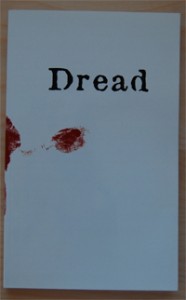 Role-playing games exist in a problematic black hole. Existing role-players play RPGs, but the hobby isn’t attracting a lot of new players (though D&D 4th Edition appears to be changing that somewhat).
Role-playing games exist in a problematic black hole. Existing role-players play RPGs, but the hobby isn’t attracting a lot of new players (though D&D 4th Edition appears to be changing that somewhat).
So how to attract new players to the hobby?
Well, last Sunday, I had the chance to run a game of Dread, and it was a revelatory experience. It might be the answer, or at least point the way towards the answer.
Dread contains a very simple system: each player gets a sheet filled with about 9 probing questions about the person they’re going to play in that evening’s entertainment. These questions are usually intrusive, like “Who forgave you just before he died?” and “What childhood toy do you still carry with you, and why?”
While the players are answering their questionnaires, the host (who runs the game) explains the situation in which the characters will be involved, and sets up a JengaTM tower. (For those unfamiliar, Jenga is a tower of wooden blocks, three blocks per level.) In our case, the characters were college students in the middle of a wilderness adventure in the Grand Canyon.
Once the players have filled out their questionnaires, they should have a good feel for the character they’re going to play, and the game begins. The host reveals the initial scene. In our case, the characters woke up in the middle of the night to the screams of their guide, and found him hauled several yards from his shredded tent, badly wounded and delirious.
The players then act out their characters. And here’s where the incredibly simple but remarkably effective system comes in. Whenever a character attempts something difficult–anything from leaping across joists in a burning building to staying calm in the face of a serial killer—the character must make a “pull,” by removing a block from the Jenga tower and placing it on the top of the tower. If a player knocks over the tower, then that player’s character dies.
As you can imagine, characters die a lot in this game.
After a character’s death, the tower is set back up, and three blocks are immediately pulled for every dead character. And the game continues.
So, it’s a game of psychological stress and horror. The three sample stories included in the book cover a werewolf attack during a camping trip (the one we played on Sunday), space marines exploring an alien-infested starship hulk, and a horny-teen slasher film, all perfect for this system.
The Jenga mechanic provides several interesting advantages:
- You can explain the mechanic in about a minute, to anyone. Those who’ve never played an RPG in their life can get into it immediately.
- It creates a literary-style wave of rising tension, release, then more tension. Because blocks are pulled after each death, the tension increases on every iteration.
- The central tower, standing in the middle of the table, is a potent reminder of the deep trouble the players face. When a player makes a pull, conversation dies. Players hold their breath. There’s actual palpable tension.
- Because there are no numbers, the host has fewer distractions and can focus on the story.
I’ve never had as much fun as I did hosting that game. Everyone enjoyed themselves.
![[Atom feed]](/user/themes/geek-archaeology/images/atom-feed.png)
![[RSS feed]](/user/themes/geek-archaeology/images/rss-feed.png)
![[iTunes podcast feed]](/user/themes/geek-archaeology/images/itunes-feed.png)